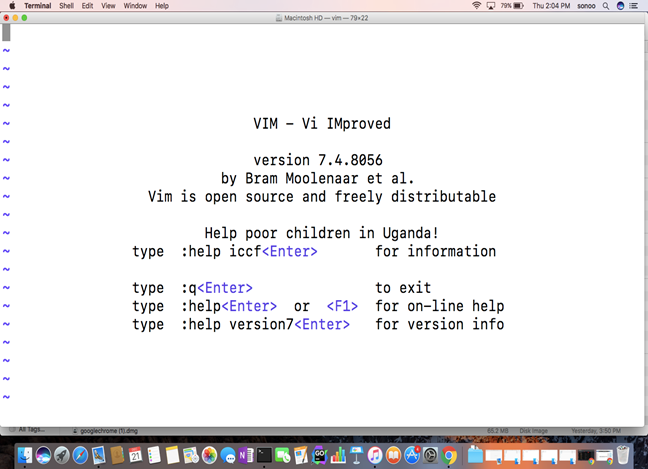The built-in script editor for the Mac OS X R GUI actually isn’t bad. In fact it is much better than its Window’s counterpart. In particular, it has:
If you're using a Mac, VIM is already installed. It's an older version (1.7), but it really doesn't matter for this tutorial. If you want to upgrade VIM on mac first, follow these steps (requires homebrew) in your terminal. About the Tutorial Vi IMproved (henceforth referred to as Vim) editor is one of the popular text editors. Headshot movie download in hindi 480p. It is clone of Vi editor and written by Bram Moolenaar. It is cross platform editor and available on most popular platforms like Windows, Linux, Mac and other UNIX variants. If you have a Windows computer, follow these instructions to install Vim on your PC. Before we begin. If you're interested in Vim but haven't started yet, these are the resources I'd like to recommend: OpenVim - Interactive Vim Tutorial; vimtutor - this is an interactive command line tutorial that's available and installed on Macs and some. This is a quick tutorial on howto use vi, or vim. It will get you started, so you open, edit, and save files. For an interactive tutorial type: vimtutor 1 Basics 2 Basic Operations 3 More Operations 4 See Also 5 Credits Normal mode When vim starts up, you will be in Normal mode. Normal mode is not for inserting text into your file but allow you to preform many operations, like saving. Vim has commands for almost every key so, when creating mappings, you must make good choices. Avoid changing the behavior of vim's most important keys/commands. Get the best orientation at:help.
- Syntax highlighting
- Auto-completion
- Bracket matching
- Auto-indent
- Block code execution (with blocked command history)
However, when coding in R and pretty much any other language, Vim has always been my goto text editor of choice. Once you get past the fairly steep learning curve, nothing comes close to it in terms of coding efficiency and navigation except perhaps Emacs, but let’s not go there.
Michael Bojanowski wrote a blog post on using R with Vim on an Ubuntu machine. One commenter asked about getting it to work on Mac OS X.
First of all, I highly recommend the MacVim port of Vim (not to be confused with macvim.org). You can get the latest version (7.3.53 at time of post) at github:
The Vim-R-plugin that Michal mentioned works on OS X with the Screen plugin as well. However, a simpler method is to use one of the following two OS X specific scripts that rely on AppleScript.
R.vim
R.vim uses AppleScript to send selected lines of code to an R buffer. Simply hit to run the selected lines in R. If R is not open, it will automatically open a new session. Note that it opens R.app instead of R64.app so if you need to run the 64-bit version you’ll have to tinker with the script a bit.
R-MacOSX
R-MacOSX is also pretty straight forward, although I couldn’t get it working properly. It defaults to to run selected lines and to source the entire file.
In either case, key mappings are customizable but personally, I have no trouble with to execute code using R.vim. Neither are as full-featured as Vim-R-plugin but I find them sufficient as all I really need is to send blocks of code to R.
I will always love you download video. Happy Vimming!
Vim Mac Os
R-bloggers.com offers daily e-mail updates about R news and tutorials about learning R and many other topics. Click here if you're looking to post or find an R/data-science job. Want to share your content on R-bloggers? click here if you have a blog, or here if you don't.Introduction


Vim which stands for vi improved is a text editor and an improved version of vi editor that is designed to run on CLI (Command Line Interface) as well as GUI (Graphical user interface) .
It was developed by Bram Moolenaar in 1991. It is a free and open source software which was released under the license which includes some charityware clauses.
In this tutorial, we will learn the steps involved in the installation of Vim on MacOS.
Prerequisites
- MacOS
- Login as an administrator on terminal.
Installation
The following steps are used to install Vim on MacOS.
1) Download the latest version
To install Vim editor on MacOS, we have to download its latest version by visiting the official website I.e. https://vim.sourceforge.io/download.php
2) Mount the disk image file
The downloaded file stored in Downloads folder (in my case) is a disk image file which needs to be mounted to the Volumes directory. mounting needs a simple command as follows.

3) Copy the application file to Applications
The file is mounted as Vim.app which is an executable application file stored inside the Volumes directory. This file needs to be copied to the Application Minecraft road. directory where the Applications are installed. This will be done via a simple command given below.
4) Unmount the file
We have done with installing vim on our MacOS. The next step which needs to be done is unmounting the file. This will be done by using unmount option with hdiutil command.
5) Working with Vim
Once we install Vim on our MacOS, we can use it for programming in any of the languages or for editing of any of the documents. To get started with the Vim, we either type simply vim on command line or we can open it via GUI by double clicking the vim icon shown in the Applications. Vim opens in the terminal which is shown in the image.

Well, we have successfully installed and get started with the VIM editor on MacOS.
Vim Mac Tutorial Free
